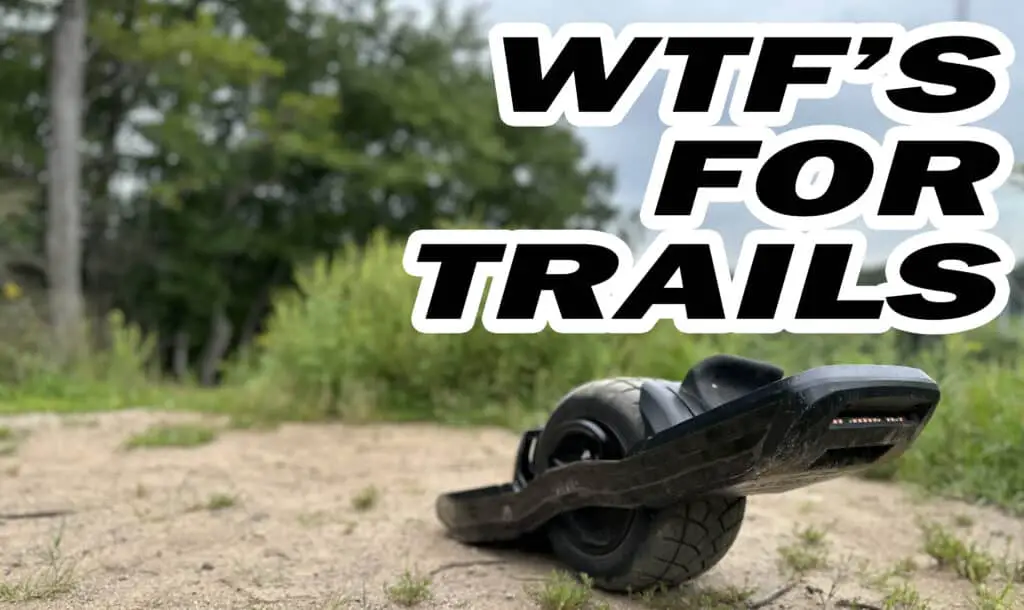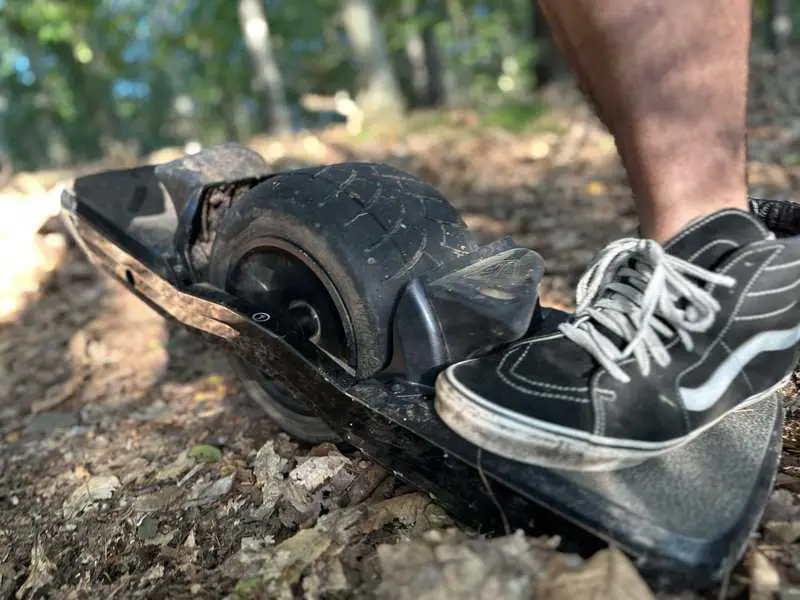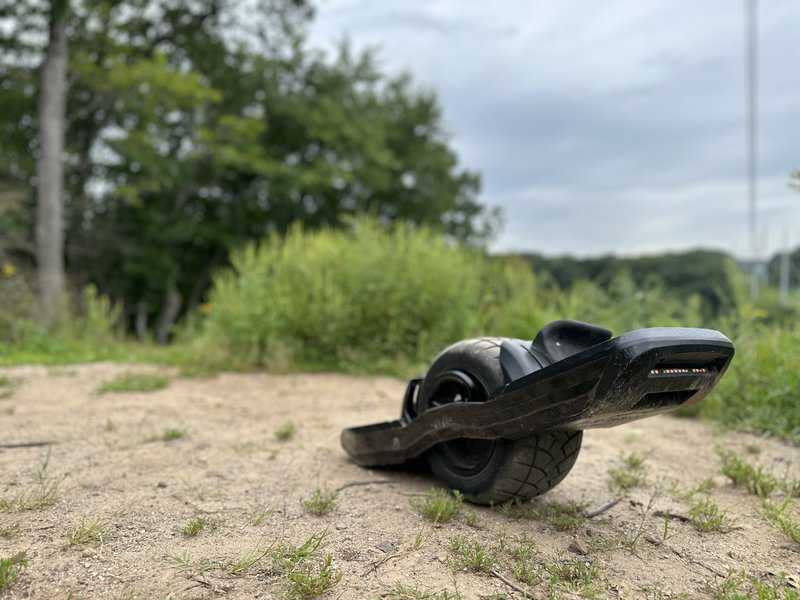
Undoubtedly, one of the most popular rails to enter the Onewheel GT space is the Homebrew WTF GT Rails. Since their initial success, they have launched a variety within the WTF brand (Steep & Deep, Standard and Lowrider). I wanted to provide a review from the trail riding side of things as I experience them. I am coming from thousands of miles logged on standard rails so I thought this could be useful for those who are in the same boat.
Lets Start with the Cons of WTF Rails
The cons are not intended to stop you from pulling the trigger. They are just here to make you aware of what could be a potential downside.
No Rail Guards – Limited Market for Rail Protection
Ok so rails on the GT have a heat trapping problem. Because the stock rails are powder coated, the rails have a hard time dissipating that heat that is transferred from the hub motor. Rail guards are probably not the best idea for GT riders however I used them and never had a problem. I am also below 200lbs and ride in New England where weather is more temperate.

If you want to keep your rails fresh, there isn’t a company as of yet that makes plastic covers for aftermarket rails. Craft and Ride does make vinyl wraps for them however you can also do this with wraps from Amazon. You would have to cut it yourself but the materials are epic. I used a clear wrap however a carbon fiber wrap could keep your rails fresh and looking great!
Elevated Nose When Riding Switch
Admittedly if you are an avid trail rider, this probably wont bother you however the most bothersome experience new riders may have is when you ride switch, the board rides elevated. This is because the controller’s sense of level is ‘off’ due to the bend in the rails.
This elevated feels actually higher than the digital profile setting made for ‘Elevated’ mode. There is a fix for this however! You need to modify the level of your Onewheel by modifying the digital tilt. This fix will rectify the normal or switch stance. It sets the level to where you want it to ride. I say this is a con because some riders do not want to alter anything on their boards and if you have certain firmware, it may not be something you can do – check our post on digital tilt setting.
Riding with a Dipped Nose
When riding standard, the nose will be dipped downward a little more than usual. This will occur until you hit pushback. This can be a good way for you to gauge your speed as you know that when your rails level out, you hit about 20mph or so. Anything before that however is going to ride a little dipped in the front which equates to a slight loss in clearance while you are riding. Again, there is a fix! It is the same fix as above so if you do have the ability to modify the tilt, then you shouldn’t be concerned.
WTF’s are advertised as no loss in clearance however this is referring to when you pull back on the nose for curb nudging. When you are actually riding, there is a slight loss in clearance as you are lowered and the nose is slightly downward. The rails are angled so the difference is slight.
Fender Bender
Standard fenders do not fit with most custom rails. So if you are fender person and you like custom rails, you will have to consider modifying the stock fender into shorties or perhaps considering the Flightshield setup that comes with FlightFins. I strongly recommend something. Riding trails without even a shorty fender will likely lead to shoe-to-tire rub. Feet will get displaced slightly on trail rides and without having anything in between the tire and your shoe can lead to the tire leaving a rubber burn on your shoe. It can also be dangerous if your foot slips to the tire.
A popular choice is putting a set of fender deletes on WTF’s. They give the board a real finished look without having to make any modifications or add Flight Fins to cover the fender gap (from not having one). They do not solve the exposed tire however. If the exposed tire is a concern, your options are:
- Shorty Fenders (Even hacking your stock ones into shorties)
- Drop Top Fender (Now available for the GT)
- Flight Fins Flightshield
- RoadsterX Fenders (similar to FlightFins – hard mounted wedge with speaker holder)
The Cost – Typically Over $400
So while this is a con, I will say that rails are probably the most valuable aftermarket component of your Onewheel. If you hold on to your stock rails, you could always sell your custom rails for a decent amount (Usually at least 50% or more depending on condition).
So even if cost is holding you back, remember that they absolutely have second-hand market appeal and value. and with that being said, with a digital tilt reconfiguration and a mini fender (Flightshield), I personally do enjoy custom rails. I do not think however I could get past the elevated riding that happens when riding switch if I could not use a digital tilt reconfiguration.
Pros to Homebrew WTF Rails
These pros outweigh the cons in my opinion. Let me first say that the best and most important pro is the lowered stance. The look is of course a huge pro. Lets go over the pros:
Lowered Stance on WTF’s
If you ever felt that your GT rides top-heavy, then WTF’s fix that concern. The drop just makes for a better ride. The hub assembly sits about a 1/2 inch higher within the rail system which lowers you (relative to the hub) and that difference can be felt on the ride. A lowered Onewheel definitely adds confidence to the rider (especially at faster speeds). I never had much issues with wobbles but a lowered board can really dial that down.
It Is a Faster Board (and I Don’t Know Why)
WTF’s stand for Wow They’re Fast however why are they fast? The top speed isn’t altered. You didn’t add any additional power to the board. However, after riding my common trail spot, I checked the app and noticed that I definitely go faster. My overall speed is higher as well as top speed. I do believe its because of the confidence that the rails instill in you. That lowered stance feels a little more nature to push the board a little faster.
I altered my digital tilt so when I do hit pushback, the nose is upwards (which I like). I definitely hear that riders like to not alter the tilt and hit the pushback so the board will level out then but within a trail system, getting to that speed is hard especially if you are riding a technical trail.
Custom Rails Look Beautiful – Aesthetically Pleasing

A set of custom rails in my opinion is the best way to give your board a major facelift. Coming from straight rails with rail guard, the board just stands out. I did add a clear vinyl wrap on my set of rails because I wanted the color to come through and still protect them. So far the rails stay mint. On the next board (my PX), I hope brushed aluminum is in stock (paint on trails will inevitably scratch).
Custom Rails are Better Heat Sinks
If you are not already aware, the hub motor uses the rails as heat sinks to dissipate the heat from the motor into the rails. Because the stock rails are powder coated and many riders also use rail guards, the heat does not dissipate as easy causing overheating (more common for heavier / southern riders). WTF’s are type 2 anodized which lets heat pass through the rails in a less restrictive manner.
Summary
If you are a particular rider and do not want to or have the ability to change the tilt of your ride then WTF rails may take some time getting use to. If however you can modify the tilt, want to improve your confidence and speed on trails, WTF’s are FTW. Have you ever experienced overheating on your Onewheel GT? Perhaps instead of adding Cold Ones or Chillers, maybe a new set of rails is in order.
I enjoy my rails. I definitely have gotten used to the lowered stance which was a little tough at first but I do get through my typical trail loops faster. Admittedly I am sometimes worried that my clearance is too low because I ride many trails with high roots and objects within the path but this might just be a hurdle I have to overcome, I haven’t had the nose catch as of yet and the concession for the faster speed and feel is worth it.
